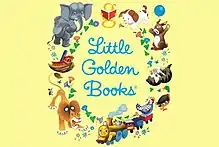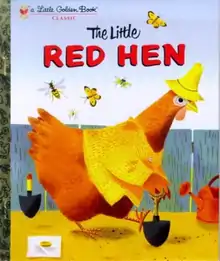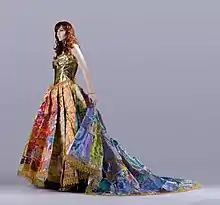Little Golden Books
Little Golden Books is a series of children's books, founded in 1942. The eighth book in the series, The Poky Little Puppy, is the top-selling children's book of all time.[1] Many of the Little Golden Books have become bestsellers,[1] including The Poky Little Puppy, Tootle, Scuffy the Tugboat, and The Little Red Hen. Several of the illustrators for the Little Golden Books later became influential within the children's book industry, including Corinne Malvern, Tibor Gergely, Gustaf Tenggren, Feodor Rojankovsky, Richard Scarry, Eloise Wilkin, and Garth Williams.
 A typical example of the Little Golden Books logo. | |
| Author | Margaret Wise Brown, Edith Thacher Hurd, Janette Sebring Lowrey, Phyllis Fraser, many others |
|---|---|
| Illustrator | Corinne Malvern, Tibor Gergely, Gustaf Tenggren, Feodor Rojankovsky, Richard Scarry, Eloise Wilkin, Garth Williams, many others |
| Country | U.S. |
| Language | English |
| Discipline | nature, science, Bible stories, nursery rhyme, fairy tales, toys, comics, cartoons, movies, television |
| Publisher | Simon & Schuster (1942–1958, 2021-present) Western Publishing (1942–2001) Golden Press (1958–2001) Random House (2001–present) |
| Published | 1942–present |
| Media type | hardcover |
| Website | www.randomhousekids.com |
Many books in the Little Golden Books series deal with nature, science, Bible stories, nursery rhymes, and fairy tales. Christmas titles are published every year. Some Little Golden Books and related products have featured children's characters from other media, such as Sesame Street, The Muppets, Disney, Looney Tunes, Barbie, Power Rangers, Thomas the Tank Engine, and others. Television and movie tie-ins have been particularly popular. Over the years Hopalong Cassidy, Cheyenne, Lassie, Rin Tin Tin, Captain Kangaroo, Mister Rogers and Donny and Marie Osmond have appeared in Little Golden Books.
The series started with Simon & Schuster; Western Printing and Lithographing Company in Racine, Wisconsin was Simon & Schuster's partner in the Little Golden Books venture, with Western handling print operations. Ownership and control of the series have changed several times since; today, Penguin Random House is the current publisher of the series.
Despite the changes of detail that occurred over the years, the Little Golden Books maintains a distinctive appearance. A copy of The Poky Little Puppy bought today is essentially the same as one printed in 1942. Both are readily recognizable as Little Golden Books. At the time of the series' golden anniversary in 1992, Golden Books claimed that a billion and a half Little Golden Books had been sold.[2]
Although the Little Golden Books have remained the backbone of the product line, the enterprise that produced the Little Golden Books has created a variety of children's books in various forms of media, including records, tapes, videos, and even toys and games. Some titles have appeared in several different formats (including "A Golden Book").
History

Georges Duplaix, who in 1940 was head of Artists and Writers Guild Inc. (a division of Western Publishing), first came up with this idea when he created new books for children. Meanwhile, a shared printing plant led Western and Simon & Schuster to develop a close relationship. In 1938, Western and Simon & Schuster released their first joint creation, A Children’s History.[3]
Duplaix had the idea to produce a colorful, more durable and affordable children's book than those being published at that time which sold for $2 to $3. With the help of his fellow Guild colleague Lucile Olge, Duplaix contacted Albert Leventhal and Leon Shimkin with his idea (Albert and Leon work for Simon & Schuster, and Albert serves as the company's vice president and sales manager).
The group decided to publish twelve titles for simultaneous release in what was to be called the Little Golden Books Series. Each book would have 42 pages, 28 printed in two-color, and 14 in four-color. The books would be staple-bound. The group first discussed a 50-cent price for the books, but Western did not want to compete with other 50-cent books already on the market. The group calculated that if the print run for each title was 50,000 copies instead of 25,000, the books could affordably sell for 25 cents each.
Mary Reed, Ph.D., a professor at the Teachers College, Columbia University, served as initial editor of the series.
The first 12 titles were printed in September 1942 and released to stores in October:[4][5]
- Three Little Kittens, by Marie Simchow Stern
- Bedtime Stories, illus. Gustaf Tenggren
- Mother Goose, by Phyllis Fraser, illus. Gertrude E. Espenscheid
- Prayers for Children, by Rachel Taft Dixon
- The Little Red Hen, illus. Rudolf Freund
- Nursery Songs, by Leah Gale, illus. Corinne Malvern
- The Alphabet from A to Z, by Leah Gale, illus. Vivienne Blake and Richard Peck
- The Poky Little Puppy, by Janette Sebring Lowrey, illus. Gustaf Tenggren
- The Golden Book of Fairy Tales, by Winfield Scott Hoskins
- Baby's Book of Objects
- The Animals of Farmer Jones, by Leah Gale, illus. Richard Scarry
- This Little Piggy and Other Counting Rhymes, by Phyllis Cerf Wagner, illus. Roberta Harris Pfafflin Petty
Three editions totaling 1.5 million books sold out within five months of publication in 1942.
Simon & Schuster editor Dorothy A. Bennett also worked with Duplaix on the Little Golden Books. Bennett became the editor of the franchise, producing books by such authors and illustrators as Margaret Wise Brown, Clement Hurd, Edith Thacher Hurd, and Garth Williams.[6][7] Bennett authored several Golden Books,[8] and introduced some of the first recorded books for children with Little Golden Records in 1948.[9]
The series underwent an expansion when Lucy Sprague Mitchell (educator and founder of Bank Street Nursery School now Bank Street College of Education) joined. A strong supporter of realistic children's literature, Mitchell created the Bank Street Writer's Laboratory. Works coming from this institution became the new basis for the Little Golden Book series, with characters and situations often inspired by the very locale of the Bank School.
As historian Leonard S. Marcus writes:
Mitchell had been in discussions with Georges Duplaix and Lucille Ogle as early as 1943 about the possibility of a special series of Little Golden Books written by members of Bank Street Writer’s Laboratory. Wartime shortages had delayed the launch of the series until 1946. The first two titles appeared that year: Lucy Sprague Mitchell's The New House in the Forest, illustrated by Eloise Wilkins, and The Taxi That Hurried, coauthored by Irma Simonton Black and Jessie Stanton, with illustrations by Tibor Gergely.[10]
In 1958, Simon & Schuster sold its interest in Little Golden Books to Western Publishing. The price of Little Golden Books rose to 29¢ in 1962.
Western introduced a line of Big Little Golden Books for slightly older children aged five and up. Some titles from this series range from brand new stories (such as The House That Had Enough) to reprints (such as The Monster at the End of This Book).
In the 1980s, Golden Books introduced Golden Melody Books. Titles from this series included a long-lasting electronic chip that played music when readers open those books. Songs featured in this series range from popular children's songs such as Twinkle, Twinkle Little Star, to songs from children's TV and movies including People in Your Neighborhood from Sesame Street and Heigh-Ho from Disney's Snow White and the Seven Dwarfs.
In the year 2000, Encore Software produced a series of "Little Golden Books" titles for CD ROM, including The Poky Little Puppy, Mother Goose, Jack and the Beanstalk, The Velveteen Rabbit, Tootle, and The Saggy Baggy Elephant. These six individual titles were some of the first major software releases to be produced entirely in Macromedia Flash.
In 2001, Random House acquired Little Golden Books for about $85 million.[11] At that point, nearly 15 million copies of The Poky Little Puppy had been sold, including copies in various languages.[12]
In 2015, with the release of Little Golden Book adaptations of the first six installments of the Star Wars saga on August 25, the Little Golden Book adaptation of Star Wars: Episode III – Revenge of the Sith became the first-ever Little Golden Book in history to come from a film that was rated PG-13 by the MPAA.[13] Months later, on April 12, 2016, a Little Golden Book adaptation of Star Wars: The Force Awakens, the next film in the saga, also rated PG-13, was released. This release opened the door for further Little Golden Books that drew upon PG-13 rated licensed film properties; some adaptations in this criteria include the 2016 reboot of Ghostbusters, Star Trek: The Original Series, characters and storylines from the Marvel Cinematic Universe, and Jurassic Park.[14][15]
Writers and illustrators
Many popular authors and illustrators have worked on Little Golden Books and related products, including:
- Sheilah Beckett
- Brian Biggs
- Mary Blair
- Ann Braybooks
- Margaret Wise Brown
- Kathleen N. Daly
- Sue Fliess
- Tibor Gergely
- Florence Johnson
- Elizabeth Orton Jones
- Phyllis Krasilovsky
- Lucy Sprague Mitchell
- Corinne Malvern
- Jim McDermott
- Ann McGovern
- Jean Miller
- Barbra Mills
- Alice Provensen and Martin Provensen
- Seymour Reit
- Feodor Stepanovich Rojankovsky
- Patricia and Richard Scarry
- Bob Staake
- Gustaf Tenggren
- Charles Spain Verral
- Jan Wahl
- Jane Werner Watson
- Eloise Wilkin
- Garth Williams
- Herbert Zim
In popular culture
Contemporary art

In 2010, Ryan Jude Novelline revealed the "Golden Book Gown", a "one-of-a-kind fairytale-inspired gown almost entirely from Golden Books...[featuring] a 22,000-square-inch page-turning skirt and a form-fitting bodice made from the spines".[16]
See also
References
Sources consulted
- "A Birthday Celebration for Golden Books..." Publishers' Weekly. 221(15):24. April 9, 1982.
- "Simon & Schuster Inc." International Directory of Company Histories. 4:671-672. 1991.
- Greason, Rebecca. Tomart's Price Guide to Golden Book Collectibles. Radnor, PA: Wallace-Homestead Book Company, 1991.
- Santi, Steve. Collecting Little Golden Books: a Collector's Identification and Price Guide, 3rd Edition. Iola, WI: Krause Publications, 1998.
- Marcus, Leonard S. Golden Legacy: How Golden Books Won Children's Hearts, Changed Publishing Forever, and Became An American Icon Along the Way. New York: Golden Books, 2007.
Notes
- Roback, Diane, ed. (Dec 17, 2001), compiled by Debbie Hochman Turvey, "All-Time Bestselling Children's Books: A listing of hardcovers that have sold 750,000 copies and paperbacks that have topped the one million copy mark over the years", Publishers Weekly.
- "Fifty Years of Books 'For the Masses.'" Publishers' Weekly. 239 (28: 28–31). June 22, 1992.
- "Western Publishing Group, Inc. History". International Directory of Company Histories. St. James Press. 1996. Archived from the original on July 24, 2012. Retrieved August 12, 2015 – via Funding Universe.
- Santi, Steve (April 29, 2009). "Once Upon a Time: The History of Little Golden Books". Antique Trader. Archived from the original on August 14, 2015. Retrieved August 11, 2015.
- "Announcing Little Golden Books." Publishers' Weekly. September 19, 1942. Pages 991-994.
- Santi, Steve (2005-08-05). Warman's Little Golden Books Field Guide: Values and Identification. Krause Publications. p. 19. ISBN 0896892654.
- Stanton, Joseph (1993-01-01). "Review of Margaret Wise Brown: Awakened by the Moon". Biography. 16 (3): 276–278. doi:10.1353/bio.2010.0391. JSTOR 23539995.
- "WorldCat, author Dorothy A. Bennett". OCLC. Retrieved 2016-04-09.
- Cunningham, Virginia (1948-01-01). "Other Publications". Notes. Music Library Association. 6 (1): 167–170. doi:10.2307/891519. JSTOR 891520.
- Marcus, Leonard S. Minders of Make-Believe: Idealists, Entrepreneurs, and the Shaping of American Children's Literature (Houghton Mifflin Harcourt, 2008).
- "Random House Lands Golden Book Assets." Publishers' Weekly. 248(33):13& 23. August 20, 2001.
- Roback, Diane; Britton, Jason, eds. (December 17, 2001). "All-Time Bestselling Children's Books". Publishers Weekly. 248 (51). Archived from the original on January 15, 2012. Retrieved June 27, 2011.CS1 maint: bot: original URL status unknown (link)
- Parrish, Robin. "Little Golden Books Are Disneyfying All 6 'Star Wars' Movies". TechTimes. Retrieved 9 July 2017.
- Liszewski, Anddrew (22 June 2016). "These Ghostbusters Little Golden Books Are Who Ya Gonna Call For a Bedtime Story". Gizmodo. Retrieved 16 July 2018.
- Frost, AJ (27 April 2018). "Breaking Down & Rebuilding Pop Culture Worlds with Arie Kaplan". ComicsBeat (Interview). Retrieved 16 July 2018.
- Diane Pham, "High Fashion as Eco-Friendly Child's Play" Archived 2012-10-03 at the Wayback Machine, Chevrolet News, 10/1/2012